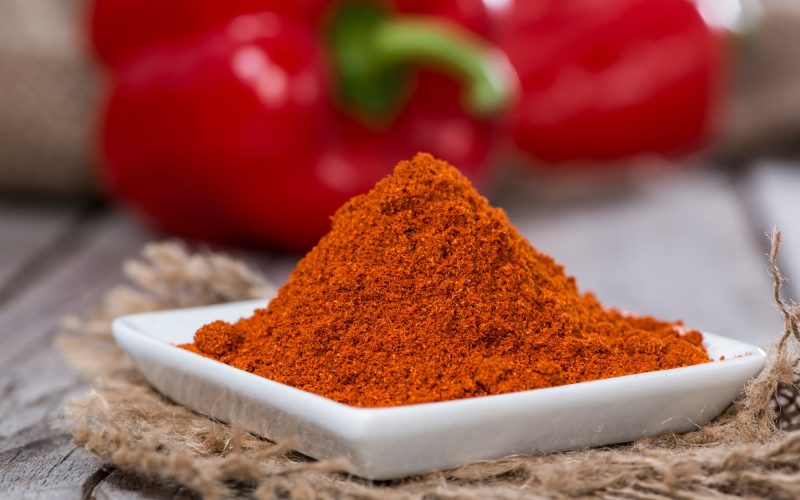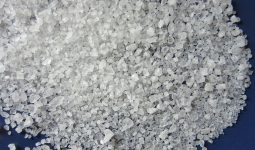Have you ever been in the middle of a cooking project when you realize that you are out of paprika?
It can be troublesome, as finding suitable substitutes for paprika, a unique spice, may seem difficult.
Paprika is one of the most popular and widely used spices worldwide.
Further, it adds an earthy flavor and colorful hue to dishes ranging from deviled eggs to roasted vegetables.
But if you find yourself unprepared with no paprika in hand, don’t worry!
Plenty of delicious substitutes for paprika can enhance the flavor and texture of your favorite dishes.
What is Paprika?
A mixture of sweet ground peppers from the Capsicum annuum family, including bell pepper and fiery chili peppers, is used to make the spice blend known as paprika.
Paprika comes in three primary varieties: smoked, sweet, and hot.
Whichever variety, this spice has a striking deep red color and a smoky, spicy, and slightly sweet flavor.
It is most known for the subtle spicy bite it gives hummus, stuffed bell peppers, and deviled eggs.
This article will explore some resourceful substitutes for paprika. Ready-made seasoning blends, smoked herbs or spices, chili powders, and more – these alternative ingredients all offer interesting flavors that enable home chefs to create gourmet masterpieces without stepping outside their front door.
Best Substitutes for Paprika
1. Chipotle Powder
First off, Chipotle powder, a type of spice made from smoked and dried jalapeno peppers, is on our list of substitutes for paprika.
It has a smoky, rich, and slightly spicy flavor that can be used in place of paprika.
Chipotle powder is an excellent substitute for paprika in recipes because it adds more complexity to dishes and can be used to create bold flavor profiles for enticing dishes.
In addition to its unique flavor profile, chipotle powder contributes to heat and color to dishes. Rather than adding a reddish hue to dishes as paprika does, the chipotle powder provides foods with an appealing smoky brown or orange-red tint.
This makes it great for sauces, marinades, dips, dressings, soups, stews, chilis, and more.
Although it may not provide the vibrant red color as traditional paprika does when sprinkled on top of food items like scrambled eggs or deviled eggs before serving them on the table, overall, its deep smokiness lends an undeniable depth of flavor, unlike any other ingredient.
2. Ancho Chile Powder
Ancho chile powder is a type of ground chili pepper that can be used as one of the excellent substitutes for paprika when cooking.
The subtle, slightly smoky flavors of ancho peppers make them a perfect alternative to the more intense kick that paprika can provide.
Ancho chile powder is made from sun-dried poblano peppers and is milder in the heat than many other chili powders.
It has sweet and earthy tones with a low spice level – making it ideal for those who don’t enjoy the more intense flavor of paprika.
Ancho chili powder is also incredibly versatile – it can kick up the flavor of everything from soups and stews to sauces, rubs, marinades, and even desserts!
Use it as a primary or secondary ingredient in any recipe for paprika.
If you want to make dishes spicier without overwhelming them with too much heat, adding some ancho chile powder can also help balance out the flavors while adding some kick – making it the perfect substitution for paprika.
3. Aleppo Pepper
Aleppo pepper, also known as Halaby pepper or chili flakes, is a spicy yet slightly smoky type of chili powder originating from Syria, on our list of substitutes for paprika.
It has become increasingly popular in recent years as it provides a rich, savory flavor to food without being overly hot or spicy.
Aleppo chili powder can be used as a paprika substitute in recipes that call for a mild heat and complex flavor profile.
Additionally, it has an earthy taste without the sweetness associated with paprika which makes it ideal for adding unique depth to dishes such as dips and marinades, soups and stews, and roasted vegetables and proteins like chicken, beef, and fish.
When substituting Aleppo pepper for paprika in recipes, it’s important to keep in mind the individual flavors of each ingredient because they will have a different effect on the overall dish.
For example, while Aleppo pepper has a moderate spice level but still has a subtle smokiness, paprika is sweet.
It doesn’t contribute heat, so there won’t be a one-to-one substitution effect.
Additionally, because of its uniqueness, it’s recommended to use smaller amounts of Aleppo chili powder compared to what you would normally use for regular paprika since it is much more pungent.
This way, you’ll avoid overpowering your dish with too much heat or smokiness from the Aleppo pepper.
4. Cajun Spice
Cajun Spice is a great substitute for paprika if you are looking for a creative way to add heat and flavor to your dishes.
This spice blend, created in Louisiana, is typically composed of several ingredients, including cayenne, garlic powder, onion powder, and dried thyme.
These combined ingredients lend a rich and flavorful profile that will warm any dish and bring out the other flavors.
Cajun Spice, which is also one of the many substitutes for paprika, can be used in various ways.
It is excellent sprinkled over eggs or potatoes for breakfast, incorporated into marinades, or rubbed onto chicken or steak before grilling or roasting and stirred into soups for added flavor and kick.
And used as an interesting salt-free rimming option for your favorite margaritas or bloody mary’s!
If you love paprika but want to switch it up occasionally with something new with an extra zing, Cajun Spice is worth trying!
You can find these spice mixes ready-made at most grocery stores, but they are also easy to put together yourself if you have access to the right ingredients.
Combining ground peppers with garlic and onion powder makes for a great base that can be adjusted and customized according to your taste preferences by adding additional herbs such as oregano, thyme, basil, or cumin!
Whether you use this blend of spices regularly or with other ingredients, Cajun Spice will liven up whatever dish you choose. Let’s proceed with other substitutes for paprika!
5. Hot Sauce

Different substitutes for paprika? Hot sauce can be an excellent substitute for paprika in many dishes.
It offers a similar smoky flavor and vibrant red color but with a spicy kick from its combination of chili peppers and spices.
While paprika is commonly used with roasted vegetables and as a dry rub on meats, hot sauce can provide just as much flavor when added to soups, pasta sauces, marinades, or any dish that requires a bit of heat.
Using hot sauce instead of paprika can add depth and complexity to the dish without overpowering the other flavors.
Depending on the type of hot sauce you choose, there are different types of heat levels available, ranging from mild to extra spicy.
For those that prefer milder dishes but still want to add some zest to their cooking, using just a few teaspoons of hot sauce rather than an entire tablespoon may do the trick without overwhelming more sensitive taste buds.
Combining other spices, such as cumin, garlic powder, oregano, and black pepper, with your hot sauce choice creates unique flavor profiles that will give any dish an unforgettable kick.
6. Guajillo Chili Powder
The Guajillo Chili Powder is also on the list of great substitutes for paprika. It is an earthy, mild chili with a hint of smokiness that adds depth and complexity to any dish.
Guajillo chili powder is made from dried guajillo chilies, ground into a fine bright red powder.
This pepper has a moderate heat level that ranges between 4,000 and 10,000 units on the Scoville scale, depending on the specific variety of guajillo chili used.
Its flavor can be earthy and sweet with hints of raisin, berry, and smoke.
Because this chili powder is slightly less powerful than other varieties, such as cayenne and chipotle powders, it’s great for adding subtler heat to dishes without overpowering them.
In addition to using it as a substitute for paprika or other hotter peppers like cayenne or chipotle, this chili powder can also be used to add flavor to dry rubs or marinades for meats like chicken or pork.
Furthermore, you can sprinkle it on top of salads or mix it into dips like sour cream or guacamole to give them an extra kick of flavor.
The bright red color of this specialty of the best substitutes for paprika also makes it an attractive garnish for tacos and other dishes where presentation matters too.
Guajillo Chili Powder makes a great substitute for paprika because its mild in heat but packs a wallop of flavor!
7. Cayenne Pepper Powder
Cayenne pepper powder is a great recipe alternative if you are looking for various substitutes for paprika.
It is a spicy, aromatic spice made from dried and ground red peppers, most commonly cayennes, that have been aged and dried to intensify the flavor.
The resulting powder has an intense but balanced heat with a mild smokiness.
Cayenne pepper powder can be used as one of the best substitutes for paprika in many recipes, such as sauces, marinades, rubs, soups, and stews.
Unlike paprika which is mostly sweet in flavor and can often be quite mild in heat, cayenne pepper powder has a more immediate kick of heat that will add quite a bit of spiciness to dishes.
In addition to adding flavor and heat to dishes, cayenne pepper powder provides some health benefits due to its high vitamin C content.
In addition, it helps reduce inflammation throughout the body and may lower cholesterol levels.
Additionally, it may improve digestion by stimulating the production of digestive juices and increasing saliva flow.
Cayenne pepper powder is easy to store for long periods without losing its potency or flavor, so it is always handy when you need more spice or want to give your food some extra zing in flavor.
Meanwhile, its vibrant color makes it an excellent garnish for dishes like chili or tacos.
So if you’re looking for something with more spiciness than paprika offers, then cayenne pepper powder is worth considering!
8. Regular Paprika and Cayenne Chili Powder
Regular paprika and cayenne chili powder are popular substitutes for paprika in many dishes, as both provide a spicy kick of heat and unique flavor.
The difference is the amount of heat they provide– regular paprika offers a milder taste, while cayenne chili powder provides more intense heat.
Cumin can also be used in place of regular paprika to add an earthy, smoky flavor and some mild heat.
When using cumin as a substitute for paprika, it’s best to start with small amounts – too much cumin can easily overpower the other flavors in the dish.
All three spices offer similar nutrition benefits, like vitamin A and iron. However, cayenne offers more health benefits than the other two spices because it contains capsaicin which is known to have anti-inflammatory properties.
9. Gochugaru Powder
Gochugaru powder is a traditional Korean spice and one of the popular substitutes for paprika, with many similarities between the two varieties.
Gochugaru powder is made from sun-dried red chili peppers and has a similar flavor to paprika, albeit with a more intense spice level.
This makes it an ideal substitute for those who value heat in their recipes.
Unlike North American paprika, which contains mostly sweet bell pepper, Gochu performs well as a table condiment due to its sharper heat and robust flavor.
In addition to acting as a suitable replacement for paprika in various dishes, Gochugaru powder is also incredibly versatile.
It can easily be used in marinades, sauces, and stews to add flavor and color.
Moreover, this Korean specialty can also be added to soups or vegetable dishes that need an extra kick.
Whatever type of dish it adds to, Gochugaru is undoubtedly one of the perfect substitutes for paprika, bringing amazing character with its spicy notes.
Depending on your tastes or the desired outcome of the dish you’re creating, you can fine-tune the spiciness level by adding more or less powder to your concoction.
10. Bell Pepper Powder
This list of substitutes for paprika won’t be complete without Bell pepper powder, which is also used in recipes to add flavor and color to any dish.
Bell pepper powder is a versatile ingredient that is easy to find in most grocery stores or online.
It has a mild spiciness similar to paprika and can be used as an all-purpose seasoning or added to specific dishes as desired.
Bell pepper powder also has health benefits due to its high vitamin content, making it a nutritious choice for home cooks.
In terms of flavor, bell pepper powder can mimic the smoky taste of paprika but at a much lower level of spice.
This makes it the perfect replacement for people who don’t like the strong kick that comes from paprika.
It is also a great option for those looking for something more vibrant than plain bell peppers with even more health benefits.
In addition, many chefs consider bell pepper powder easier to use than traditional paprika because it dissolves more readily in liquids and doesn’t require as much prep time since it’s already in powdered form.
Considering all these factors, bell pepper powder is an excellent substitute for paprika and will give your cooking that unique flavor you’ve been searching for!
11. Crushed Red Pepper Flakes
Crushed red pepper flakes are excellent substitutes for paprika when you need a bit of heat.
These spicy, red flakes are made from dried and crushed cayenne peppers, which give them their signature bright red color and mild-to-medium heat.
When used correctly, these red pepper flakes can make a great substitute for paprika, which is often milder in flavor.
When substituting crushed red pepper flakes for paprika in recipes calling for the latter spice, it can be helpful to keep the ratio at 1:1.
One teaspoon of crushed red pepper flakes is equal to one teaspoon of paprika in terms of the amount of spice it provides.
Of course, if you like more or less heat than what comes with a teaspoon’s worth, then adjust the amount accordingly.
The best way to use crushed red pepper flakes as one of the substitutes for paprika is to add them toward the end of cooking time so that they retain some of their spicinesses.
They also work well sprinkled on top of finished dishes such as pizza or even avocado toast just before serving – remember, a little goes a long way!
12. Sweet Paprika
Sweet paprika and regular paprika are both viable substitutes for each other.
Both are made from ground-dried chili peppers and offer a vibrant red hue and a mild, sweet flavor that pairs very well with many dishes.
However, there are some differences between the two types of paprika.
Sweet paprika is generally milder than regular paprika, as it comes from crushed sweet or bell peppers.
In contrast, regular paprika is derived from pimento or chili peppers and offers more intense heat.
Additionally, sweet paprika tends to be slightly sweeter in flavor and has a softer texture than regular paprika, which can result in different flavor profiles when used in recipes.
There are alternatives to sweet or regular paprika, such as smoked paprika, turmeric powder, cayenne pepper, and chili powder – all of which will offer a different flavor profile than traditional paprikas.
Ultimately, the substitute choice depends on an individual’s preferred taste profile. We still aren’t done with this list of the best substitutes for paprika!
13. Tomato Sauce and Chili Powder
Tomato sauce and chili powder can be great substitutes for paprika in certain dishes.
The two ingredients have a similar flavor profile, but the tomato sauce adds more sweetness.
In contrast, the chili powder brings a little heat, making the combination a flavorful alternative to paprika.
Tomato sauce adds color and a rich, acidic flavor to dishes such as tacos, enchiladas, or shepherd’s pie.
Meanwhile, chili powder adds extra spiciness to recipes like sloppy joes, burgers, or chilies.
The combined two ingredients give the dish an intense and unique smoky flavor that cannot be achieved with either alone.
By experimenting with amounts and trying different combinations of sauces and spices, you can create delicious recipes infused with your favorite flavors!
14. Chili Powder
Lastly on this list of the best substitutes for paprika is chili powder, often a great alternative as it is made from various types of hot peppers ground into a fine powder.
It can be used in many recipes and is especially popular in Mexican dishes such as chili con carne.
The main difference between chili powder and paprika is that the former has a much spicier taste, as it contains cayenne pepper.
In contrast, paprika is milder and sweeter, with only hints of spice.
When substituting chili powder for paprika, it’s important to remember that a little bit can go a long way since it has a more concentrated flavor than paprika does.
Furthermore, because ground chilis come in different varieties and each brand or type has its own spiciness, it’s important to adjust the amount added to recipes or dishes carefully.
For example, if substituting 1 tablespoon of paprika for 2 tablespoons of chili powder when cooking tomato sauce for pasta or lasagna, start by adding just one tablespoon of chili powder at first and then wait to taste before adding more after cooking time if necessary.
We’ll wrap up this list of the different substitutes for paprika here!
Conclusion
In conclusion, paprika has many potential substitutes that can provide similar flavor, color, and heat to dishes.
Substitutes for paprika include chili powder, cayenne pepper, or even smoked paprika, and may be used depending on the desired flavor profile.
There are also creative options, such as sambal oelek paste and garlic powder with a small amount of cayenne for a stand-in for regular paprika.
Whatever ingredient is chosen in place of paprika should be added sparingly to avoid overpowering the dish.
Frequently Asked Questions
Paprika is frequently used as a condiment to give sauces, soups, stews, and salads a fiery bite. In addition to providing the perfect finishing touch for hummus and deviled eggs, it is a typical component of spice rubs and blends.
There are several health advantages of paprika. It is a fantastic source of antioxidants, strengthening the body’s defenses, reducing gas, and fending off cancer and heart disease. But remember that eating too much at once could irritate your stomach and result in perspiration and a runny nose.








